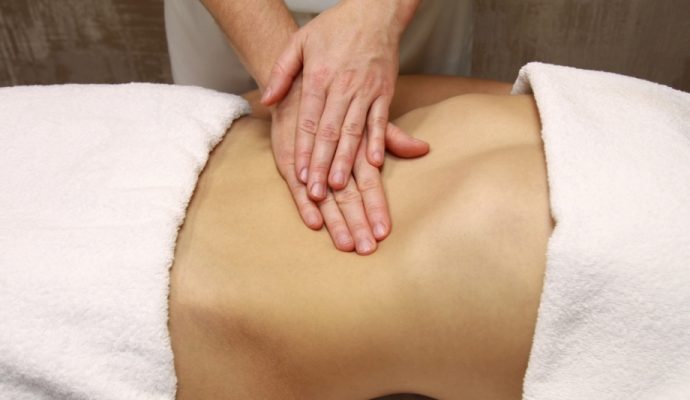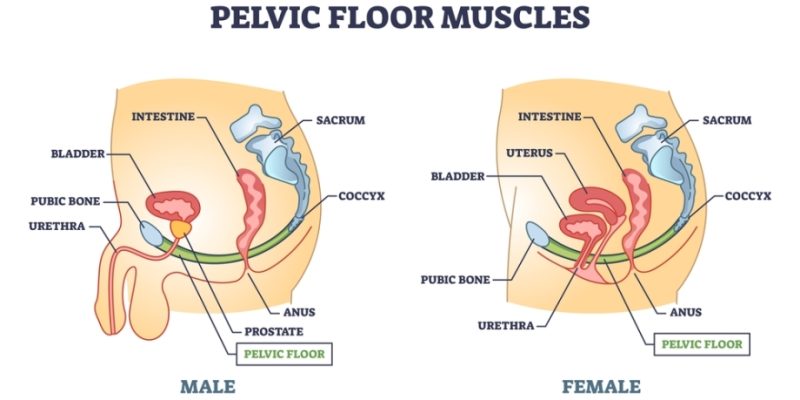
With regard to our book about Abdominal Massage I have been asked what the difference is between Abdominal Massage and Pelvic Massage. I will shed some light on this question in the remainder of this post.
First of all, to define if a massage treatment modality is either an Abdominal Massage (also called Abdomen Massage) or rather a Pelvic Massage (also called Pelvis Massage or even Pelvic Floor Massage) one needs to know what area of the body is treated, that is, either the abdominal cavity or pelvic cavity.
Abdominal, Pelvic, and Abdominopelvic Cavity

Anatomically, there’s often a separation made between the abdominal cavity and the pelvic cavity. Nevertheless, both cavities together are called the abdominopelvic cavity. To make things a bit more confusing: often the abdominopelvic cavity is simply referred to as the abdominal cavity. In fact, there’s no membrane or other bodily structure that separates the abdominal cavity from the pelvic cavity, and the separation is rather a technical definition, not so much a real practical one; it’s basically one continues body cavity.

Now, from out a technical-anatomical viewpoint, the abdominal cavity (upper part of the abdominopelvic cavity) contains organs such as the stomach, a part of the esophagus, liver, pancreas, spleen, gallbladder, kidneys, small intestine, and most of the large intestine. In addition, the diaphragm is usually seen as part of the abdomen, in any case as far as it concerns Abdominal Massage therapy. Yet, technically the diaphragm is the separation between abdominal cavity and thoracic cavity [chest cavity]).
The pelvic cavity (lower part of the abdominopelvic cavity) contains the urinary bladder and the rest of the urinary tract system, the lower portion of the large intestine (including rectum and anal canal), and the internal reproductive organs i.e. internal genital organs (vagina, uterus, ovaries, the fallopian tubes, and prostate).
In addition, again as far as it concerns massage therapy, the pelvic cavity includes the pelvic floor i.e. pelvic floor muscles. Nevertheless, the pelvic floor is officially a separator (a muscular membrane or layer) between the pelvic cavity and the perineal area below it. Again, somewhat confusing, in some definitions the perineal area (often simply called the perineum) is also included as part of the pelvic region or pelvic cavity.
Mind also that most physicians don’t make a difference between abdominal organs and pelvic organs. That is, they would often say that the urinary bladder, uterus, fallopian tubes, ovaries, and prostate are abdominal organs. Then again, others might explicitly refer to them as pelvic organs.
Abdominal Massage or Pelvic Massage?

Hence, when you would massage organs, ligaments, fascia, and other soft tissues that are defined as residing in the abdominal cavity one would say that the treatment is an Abdominal Massage, and when you massage organs or other soft tissues belonging to the pelvic cavity it would be a Pelvic Massage.
Yet, the term Pelvic Floor Massage is actually only applicable when manipulating the pelvic floor structure, but — as said before — you’ll often notice that the terms Pelvic Massage and Pelvic Floor Massage are used synonymously.
Now, in massage therapy, in a more general sense, we could say that all pelvic massages are abdominal massages, but that not all abdominal massages are pelvic massages. For instance, an Abdominal Massage that predominantly focuses on the small intestines or perhaps mostly on the diaphragmatic area wouldn’t be defined as a Pelvic Massage. Then again, a Vaginal Massage or a Uterus Massage could be defined as a Pelvic Massage, but also as an Abdominal Massage.

In addition, you can have external abdominal massages and internal abdominal massages. Internal abdominal massages would access the inside of the body either through the vaginal canal or through the anal canal, and external abdominal massages would access the abdominal cavity from the outside of the body. In fact, internal abdominal massages typically access the pelvic cavity and could be defined as pelvic massages.
Moreover, many pelvic massages are actually so-called genital massages or fertility massages that manipulate the genital i.e. reproductive organs (vagina, uterus, ovaries, the fallopian tubes, and prostate), apart from those pelvic massages that rather work with the pelvic floor, perineum, or with the urinary tract system (although even the latter could address genital or reproductive issues).
Mind also that various abdominal massages, such as Maya Abdominal Massage and Chi Nei Tsang Abdominal Massage, also work with/on the ribcage, and thus thoracic cavity, which would additionally qualify them as a Thoracic Massage.
Well, at any rate, I hope to have enlightened the question of what would be the difference between a Pelvic Massage and Abdominal Massage, and not have added to the confusion 🙂
















